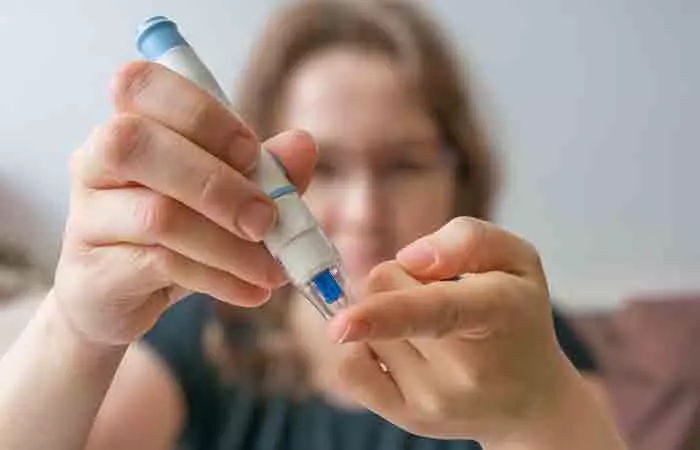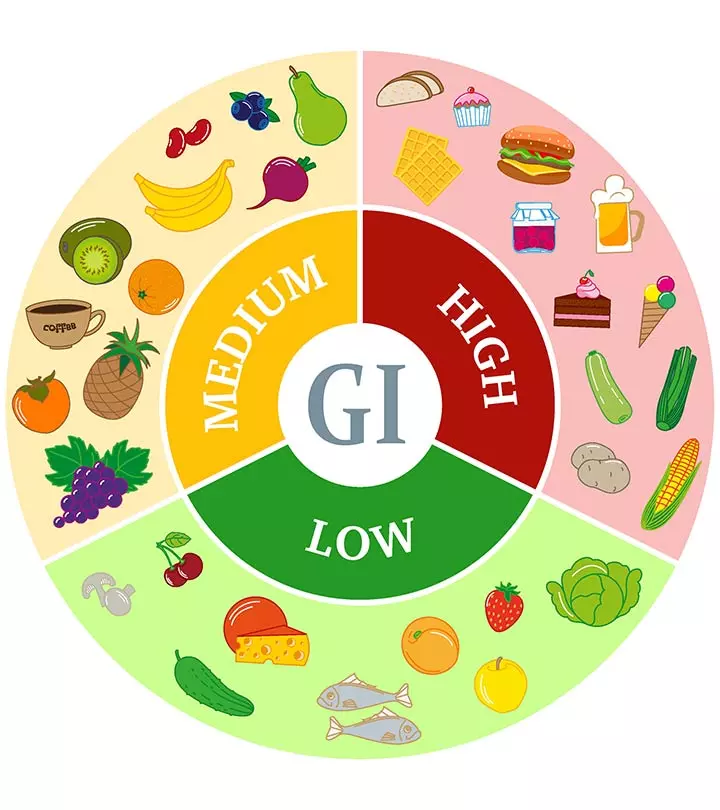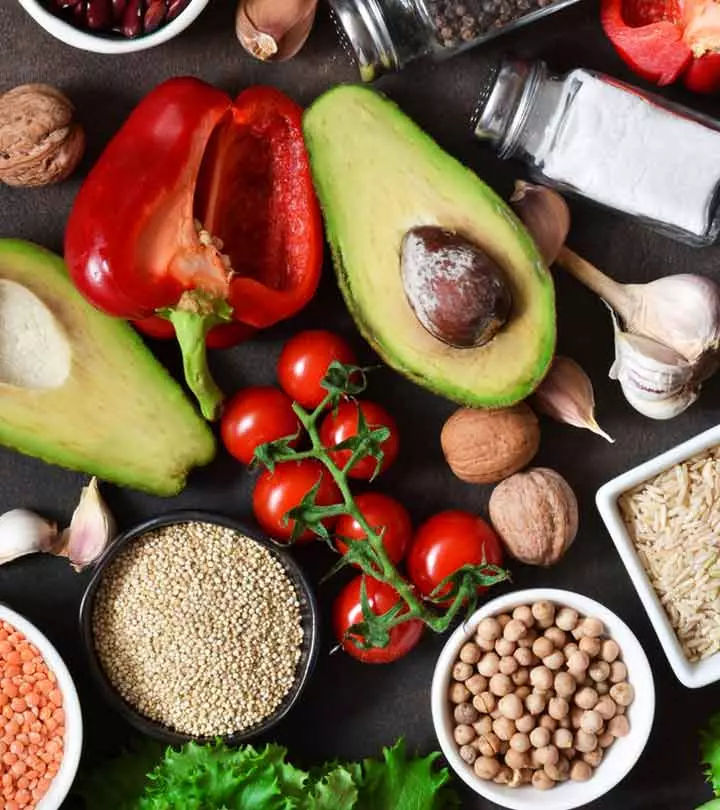Prediabetes Diet Plan: 7-Day Meal Guide To Lower Blood Sugar
A balanced diet plan and foods to help you begin your journey to a diabetes-free life.

Image: Midjourney/ StyleCraze Design Team
A prediabetes diet plan is recommended for people with high blood sugar levels that may progress to diabetes. Prediabetes is a warning bell. It is a condition where the blood sugar levels are higher than normal but not high enough to be labeled as diabetes yet (1). It is estimated by the Centers for Disease Control and Prevention (CDC) that by 2030,about 84 million Americans and 470 million people in the world may have prediabetes (2), (3). It’s time to devise a nutritional and lifestyle strategy to curb disease progression and potentially reverse prediabetes.
A study conducted by CDC in the US between 2005-2008 and 2017-2025 tried to yield the percentage of US adults suffering from prediabetes, i.e., blood sugar level between 100-125 mg/dL when fasting. It also recorded the percentage of adults with prediabetes who have been informed at some point of their prediabetic status. Take a look at the graph below.

Prevalence and Notification of Prediabetes Among US Adults (in %)
Source: PrediabetesYou can go on a prediabetes diet, a holistic approach encompassing a balanced diet and a healthy lifestyle. It helps reduce the risk of type 2 diabetes and other health issues (4). In this post, nutritionists specializing in diabetes treatment recommend some foods to eat and avoid, a prediabetes menu plan, and lifestyle changes needed to reverse prediabetes. Scroll down!
 At A Glance: Prediabetes Diet
At A Glance: Prediabetes Diet- Principle: A balanced and nutritious diet comprising vegetables, fruits, whole grains, and low-glycemic index foods.
- Purpose: To manage prediabetes and reduce the risk of type 2 diabetes.
- Who It Is For: Individuals with high blood sugar levels that may progress to diabetes.
- Duration: Long-term
- Cons: May cause fatigue and tiredness initially.

In This Article
What Is Prediabetes? What Causes It?

Prediabetes is a condition in which the blood glucose levels are higher than normal (fasting plasma glucose at 7.0) but not high enough to be diagnosed as diabetes. Diana Gariglio-Clelland (RD, Certified Diabetes Care & Education Specialist) says, “Having prediabetes is a major risk factor for developing type 2 diabetes. Up to 70% of people with prediabetes are estimated to get diabetes in their lifetime, according to an expert panel from the American Diabetes Association.” (5)
What causes prediabetes? Jill Weisenberger (MS, RDN, CDCES, CHWC, FAND, and Author of Prediabetes: A Complete Guide) explains, “Prediabetes is a sign of a greater metabolic problem involving insulin resistance, loss of insulin production, or both.” Insulin is a hormone produced by the pancreas that helps lower blood sugar levels.
Mary Wirtz (MS, RDN, CSSD) breaks down the main contributors of prediabetes (6):
- Family history and genetics
- Diet and lifestyle factors (such as physical inactivity, stress, insomnia, drinking too much, and smoking)
- Overweight and obesity as well as undernutrition in case of type 1 diabetes
- Insulin resistance and early beta-cell failure to produce insulin
 Did You Know?
Did You Know?According to the CDC, 38% of the US adult population (18 years or older) and 48.8% of people aged 65 years or older have prediabetes (7).
Note: Not everyone diagnosed with prediabetes will become diabetic, provided they work towards healing themselves.
Incorporating a well-balanced diabetes diet may help stabilize blood sugar levels. Given that there are so many factors that contribute to developing prediabetes, who is at more risk of developing it? Find out in the following section.
Key Takeaways
- According to American Diabetes Association, about 70% of those with prediabetes are diagnosed with diabetes in their lifetime.
- Studies suggest that western diets are more susceptible to prediabetes.
- Hence, it is recommended to go for foods low in carbs and rich in fiber. Also, make it a point to avoid sugary drinks and refined carbs.
Who Is At More Risk Of Prediabetes?
The CDC mentions a list of people who are more likely to develop prediabetes (2). You may develop prediabetes if:
- You are overweight or obese.
- Have an increased waist size (>40” for men and >35” for women).
- Have a strong family history of diabetes.
- Are over 45 years of age.
- Consume a very processed diet.
- Are physically inactive.
- Smoke regularly.
- Have PCOSi A common disorder that affects the functioning of a woman's ovaries, caused by an excess production of male hormones. .
- Have gestational diabetes (diabetes during pregnancy).
- Are African-American, Hispanic/Latino-American, American-Indian, Pacific Islander, or Asian-American.
According to a report, the estimated prevalence of prediabetes in 2019 among U.S. adults of age 18 years or more is 96 million (1 in every 3 adults). It was found that men were more at risk of prediabetes (41%) than women (31%) in 2017-2025.
Before you jump to conclusions, you must know the tell-tale signs of prediabetes and how to confirm it. In the following section, you will learn about the symptoms and diagnosis of prediabetes. Scroll down.
Symptoms And Diagnosis
Unlike many other diseases and conditions, prediabetes does not have any concrete symptoms. However, if you have a family history of diabetes or are overweight or obese, have issues with weight management or have PCOS, and are over 45 years of age, it is a good idea to get your blood glucose levels checked.
However, in rare cases, some people may experience symptoms like (1):
- Increased appetite
- Unexplained weight loss or weight gain
- High body mass index (BMI)
- Weakness
- Fatigue
- Sweating
- Blurred vision
- Slow-healing cuts or bruises
- Frequent skin infections
- Bleeding gums
says, “The most accurate way to diagnose prediabetes is through a hemoglobin A1C test (HBA1C), which measures your average blood sugar over the past 60-90 days. A normal A1C is below 5.7, whereas prediabetes is diagnosed with an A1C of 5.7-6.4 (6.5 is the beginning of the diabetes range).”
If you are diagnosed with prediabetes, switch to a prediabetes diet. A study published in the journal Nature confirms that a poor quality diet poses an increased risk of developing prediabetes (8). A study was conducted on the dietary pattern of 1761 Chinese people of 45-59 years of age for over a year. The researchers concluded that a Western-pattern diet posed a higher risk of prediabetes compared to a diet comprising of grains and vegetables (9).
The prediabetes diet mainly focuses on including foods with a low glycemic index. Knowing more about the glycemic index helps promote mindful eating, which is beneficial for those trying to manage their blood sugar levels. Scroll down to learn more.
What Is The Glycemic Index (GI)?
The glycemic index is a scale that ranks foods on how they affect your blood sugar. It measures how quickly carbohydrates in foods are digested in your body and converted into glucose in the bloodstream. Here are three categories of foods you should know about based on their glycemic index (10):
- High-GI Foods: These include foods like white bread that increase your blood sugar levels significantly.
- Intermediate-GI Foods: These include foods like wholemeal bread that have a moderate impact on blood sugar levels.
- Low-GI Foods: These include foods like legumes that have a minimal impact on blood sugar levels.
A BMJ analysis reports that a low-calorie and low-carbohydrate diet is a promising nutritional intervention for prediabetes (11).
What are these foods that are nutritious yet low in calories and carbs? Which foods are high in carbs? Check out the list of prediabetes foods to eat and avoid below.
Prediabetes Diet Foods List As Per Expert Recommendations
Prediabetes diet is all about making smart food choices. Mary Wirtz (MS, RDN, CSSD) advises, “Consider substituting fresh fruit or a handful of almonds for your nightly bowl of ice cream.” She adds, “Also, there are many nutritious foods to include regularly – vegetables, fruits, grains (ideally whole grains, more than 50% of the time), protein including fish, skinless poultry, beans and lentils, low-fat dairy, and healthy fats.”
Jill Weisenberger (MS, RDN, CDCES, CHWC, FAND, and Author of Prediabetes: A Complete Guide) says, “I always recommend avoiding sugary drinks like sodas and teas. They are linked to an increased risk of prediabetes and type 2 diabetes. I’m a big fan of a Mediterranean-style diet to dial back prediabetes. I also recommend low glycemic index foods like oats and barley because they have the fiber called beta-glucan, which helps improve insulin sensitivity.” Diana Gariglio-Clelland (RD, Certified Diabetes Care & Education Specialist) advises limiting sugar-sweetened beverages, refined carbs like sweets, white bread, etc., and focusing on whole foods instead of overly-processed foods that are low in fiber and nutrients.
Keeping the experts’ recommendations in mind, here’s a downloadable list of foods to eat and avoid if you have prediabetes.

Weisenberger also reminds us not to overeat. She says, “Reducing your food intake will lessen insulin resistance even without large amounts of weight loss. For those people who are overweight or obese , I recommend aiming to lose 5-7% of your starting weight.” Also, practice portion control to get maximum benefits. Also don’t eat when not hungry and eat when you are. Listen to your body. But if you are not sure how to design your diet, here’s a sample diet chart and a 7-day meal plan for prediabetes to get you started. Take a look!
Sample Prediabetes Diet Chart
| Meals | What To Eat |
|---|---|
| Early Morning (6:00a.m.) | 2 teaspoons fenugreek seeds soaked in a cup of water overnight |
| Breakfast (7:00a.m.) | 2 soft-boiled eggs (or baked beans) + 4 almonds + 1 cup milk (or soy milk or green tea) |
| Mid Morning (10:00a.m.) | 1 cup muskmelon/1 apple + ½ cup plain yogurt |
| Lunch (12:30p.m.) | 3-5 oz tuna/chicken/tofu + 1 cup boiled/raw vegetables + ½ cup greens + 350 ml buttermilk |
| Snack (3:30p.m.) | 1 cup green tea + 1 digestive biscuit |
| Dinner (6:30p.m.) | 1 cup lentil soup with veggies or 3 oz. grilled fish with vegetables + 1 cup milk with a pinch of turmeric before bed |
One may also add apple cider vinegar to the diet as it helps manage blood glucose greatly. These sample diet charts can be effectively followed if you have a clear strategy.
Meal Planning Strategies
When planning meals for a prediabetes diet, consider these strategies:
- whole foods like vegetables, lean proteins, and whole grains.
- Incorporate balanced meals by including a mix of carbohydrates, proteins, and healthy fats to help stabilize blood sugar levels.
- Practice portion control by using smaller plates and bowls. Pay attention to serving sizes recommended for each food group to avoid overeating.
- Prepare meals in advance. Cook and portion food for the entire week to save time and make healthy eating easier. Batch cooking can help you stay on track.
- Allow flexible room for adjustments in your meal plan to accommodate cravings or unexpected events while maintaining healthy choices.
Based on these strategies, here is a 7-day plan that can help you fight prediabetes.
7-Day Meal Plan For Prediabetes
| DAY | EARLY MORNING | BREAKFAST | MID-MORNING | LUNCH | SNACK | DINNER |
|---|---|---|---|---|---|---|
| Monday | 2 teaspoons fenugreek seeds soaked in a cup of water overnight | 1 cup cooked oatmeal with 1/2 oz. chopped almonds | 1 large peach | 6-inch whole wheat pita bread + a bowl of Salmon Caesar salad | Green tea + 1 digestive biscuit | A bowl of skinless chicken breast salad + 1 cup milk with a pinch of turmeric before bed |
| Tuesday | 1 teaspoon apple cider vinegar in a glass of warm water | 1 slice whole wheat bread with 1 tablespoon peanut butter, and 1/2 banana | 1/2 cup baby carrots + 1/4 cup hummus | 1 cup quinoa salad with 3 oz. grilled chicken | 1 oz. 70% dark chocolate + 5 whole walnuts | A bowl of lentil pesto pasta + 1 cup milk with a pinch of turmeric before bed |
| Wednesday | 2 teaspoons fenugreek seeds soaked in a cup of water overnight | 2 soft-boiled eggs + 4 almonds + 1 cup soy milk | 1 cup Greek yogurt + 3 whole walnuts | 2 slices whole wheat bread sandwich with tomatoes and tuna mixed with 1 tablespoon mayonnaise | 12 tortilla chips +1/4 cup guacamole | 1 cup lentil soup with veggies + 1 cup milk with a pinch of turmeric before bed |
| Thursday | 1 teaspoon apple cider vinegar in a glass of warm water | A bowl of cooked oatmeal + 1 tablespoon peanut butter + 5 large strawberries | 1 kiwi or orange + 6 almonds | 1/2 cup cooked quinoa with vegetables + 1 cup buttermilk | Green tea + 1 cup of plain popcorn | 3 oz. grilled fish with vegetables + 1 cup milk with a pinch of turmeric before bed |
| Friday | 2 teaspoons fenugreek seeds soaked in a cup of water overnight | 1 cup Greek yogurt + 1/2 cup whole-grain cereal + 1/2 cup raspberries | 1 large apple | 1 whole-grain tortilla wrap with 4 oz. sliced turkey and 1 sliced tomato | One slice whole wheat bread + 1 tablespoon peanut butter | 4 oz. turkey burger+ 1 cup baby carrots +1 cup milk with a pinch of turmeric before bed |
| Saturday | 1 teaspoon apple cider vinegar in a glass of warm water | 1 slice whole wheat bread + 1 poached egg + 1/2 medium avocado | 1 brown rice cake + 1 tablespoon peanut butter | 3 oz. tofu + 1 cup boiled vegetables + 1 cup buttermilk | Green tea + 1 chocolate chip cookie | 3 oz. grilled steak + 12 Brussels sprouts +1 cup milk with a pinch of turmeric before bed |
| Sunday | 2 teaspoons fenugreek seeds soaked in a cup of water overnight | 1 cup baked beans + 4 almonds + 1 cup plant-based milk | 2 small chocolate chip cookie | 3 oz. grilled chicken + 1 cup steamed greens | 1 cup whole milk ice cream | 4 oz. tofu baked in teriyaki sauce + 1 cup brown rice+1 cup milk with a pinch of turmeric before bed |
Apart from healthy eating, you must also tweak your lifestyle. Here’s a list of favorable lifestyle changes that can help reverse prediabetes.
Prediabetes Lifestyle Changes
Data suggests that lifestyle changes decrease the risk of prediabetes progressing to diabetes for about 10 years (12)! Here are the recommended lifestyle changes:
- Exercise Regularly

Exercising is extremely beneficial if you are overweight, obese, or have PCOS. The American Diabetes Association confirms that exercising helps manage blood glucose levels (13). Working out also helps burn calories and improves fitness, balance, limb and eye coordination, reflex, and flexibility. Most importantly, exercising regularly helps release endorphinsi Chemicals the body releases in response to stress or pain to reduce discomfort and increase pleasure. that improve your mood and mental wellbeing.
Choose an exercise routine that you love, have fun doing, and can adhere to. If you love sports, play sports to stay active. The Centers For Disease Control and Prevention (CDC) recommends engaging in 30 minutes of brisk walking or an exercise of your choice daily to reduce the risk of developing type 2 diabetes (2). You can choose running, swimming, dancing, bodyweight exercises, weight lifting, HIIT, kickboxing, etc. There is no one-size-fits-all here. Mix up your workout routine (cardio and strength training every alternate day) to get the maximum output.
- Sleep Well
Poor sleeping habits, not getting enough sleep, and sleep disorders are closely related to developing diabetes. Scientists believe a sedentary lifestyle, smoking, increased food intake, insulin resistance, and overuse of alcohol are interlinked with poor sleep quality and diabetes risk (14).
This is another reason to exercise regularly and eat healthily. Rebalancing the hormones, reducing inflammation and hunger hormones, and improving mental wellbeing are key to improving your sleep (15), (16). Turn off your electronic gadgets, read a book, and maintain a strict bedtime to sleep well.
 Did You Know?
Did You Know?- Manage Stress

A study found a significant association between hypertensioni A condition characterized by abnormally high blood pressure levels that increase the risk of heart disease, stroke, and other issues. , physical activity, BMI, and diabetes. Scientists found that moderate to high stress levels caused a 2.3-fold increase in the odds of diabetes three years later (18). Reducing stress comes with practice and patience.
For starters, exercise to release the beneficial endorphins. Gradually get into practicing meditation. Pick up a hobby and learn a new skill to keep yourself occupied. Keep short-term goals and reward yourself for every milestone you achieve.
These are the main lifestyle changes that can help you reverse prediabetes and prevent it from progressing to full-blown diabetes. However, are dietary and lifestyle interventions enough? Scroll down to know more.
Are Food And Lifestyle Changes Enough To Reverse Prediabetes?

Food and lifestyle changes are effective most of the time. However, factors leading to prediabetes are complex, and different people respond differently to dietary and lifestyle interventions. Wirtz agrees. She says, “Each individual is truly different, though it [diet and lifetsyle] plays a large role in helping to prevent the progression to type 2 diabetes.”
Ken Berry, a doctor, shared his experience of reversing prediabetes. He said, “I got rid of all the junk food. I started eating lots of whole grains and lots of fruits and vegetables. I started jogging 3 or 4 days a week (i).”
The best way to know if you are responding to nutritional therapy and lifestyle change intervention is to get your blood glucose checked every four weeks. Talk to your doctor to see if you need to go on medications.
Infographic: 4 Lifestyle Changes You Need To Make If You Have Prediabetes
If you want to reduce the risk of diabetes, it is essential for you to take certain steps. These steps include making some lifestyle changes so that your prediabetes does not progress into full-blown diabetes in a matter of months. Check out the infographic below to know more about the lifestyle changes that you should implement to prevent a swift progression to type 2 diabetes.
Some thing wrong with infographic shortcode. please verify shortcode syntax
The prediabetes diet plan aims at leveling your blood sugar control and preventing progression to type-2 diabetes. The diet involves eating whole grains, vegetables, fruits, fish, skinless poultry, lentils, beans, and low-fat dairy and excludes all processed junk foods/drinks. Also, consume fiber-rich foods like oats to improve insulin sensitivity. Following the diet chart focuses on balanced nutrition and meal planning can be an effective way for diabetes prevention. Also, you need to make changes to your lifestyle by way of exercising regularly, avoiding smoking and drinking alcohol, leading a stress-free life, and getting a good night’s sleep.
Frequently Asked Questions
How often should I check my blood sugar levels?
If you are prediabetic, it is ideal to check your blood sugar levels every 3 to 6 months, but your doctor may suggest more frequent testing based on your condition. If you are managing diabetes, you might need to check your levels daily or several times a week, depending on your treatment plan. Always follow your healthcare provider’s advice for the best approach.
How long does it take to go from prediabetes to normal?
Anecdotal evidence suggests that it takes about 3-10 years to reverse the effects of prediabetes. Strict dietary and lifestyle changes are required to control your blood sugar levels.
Is coffee OK for prediabetes?
Yes. A study found that long-term coffee consumption may be linked with a lower risk of prediabetes and type 2 diabetes (19). However, avoid adding sugar to your coffee.
Is avocado good for prediabetes?
Yes. Avocados have relatively low sugar and carbohydrate content and consuming them does not spike blood sugar levels.
Is peanut butter good for prediabetes?
Yes. Peanuts and peanut butter are low GI and GL foods, and they contain beneficial nutrients that help manage blood sugar levels.
Illustration: Prediabetes Diet Plan: Risks, Foods, & Lifestyle Changes

Image: Stable Diffusion/StyleCraze Design Team
It is possible to reverse prediabetes by making some healthy choices in your day-to-day life. Watch this video to learn how to do food journaling and find out some essential diet changes, lifestyle modifications, and exercises to reverse prediabetes.
Personal Experience: Source
StyleCraze's articles are interwoven with authentic personal narratives that provide depth and resonance to our content. Below are the sources of the personal accounts referenced in this article.
i. How I Reversed PreDiabetes & You Can Toohttps://www.youtube.com/watch?v=91ZddXkeGFw
References
Articles on StyleCraze are backed by verified information from peer-reviewed and academic research papers, reputed organizations, research institutions, and medical associations to ensure accuracy and relevance. Read our editorial policy to learn more.
- Prediabetes
https://www.ncbi.nlm.nih.gov/books/NBK459332/ - Prediabetes – Your Chance to Prevent Type 2 Diabetes
https://www.cdc.gov/diabetes/prevention-type-2/prediabetes-prevent-type-2.html?CDC_AAref_Val=https://www.cdc.gov/diabetes/basics/prediabetes.html - Prediabetes: A high-risk state for developing diabetes
https://www.ncbi.nlm.nih.gov/pmc/articles/PMC3891203/ - The Effectiveness of Different Diet Strategies to Reduce Type 2 Diabetes Risk in Youth
https://www.ncbi.nlm.nih.gov/pmc/articles/PMC4997399/ - Prediabetes: A high-risk state for developing diabetes
https://www.ncbi.nlm.nih.gov/pmc/articles/PMC3891203/ - Pathophysiology of prediabetes
https://pubmed.ncbi.nlm.nih.gov/16570762/ - National Diabetes Statistics Report
https://www.cdc.gov/diabetes/php/data-research/index.html - Association between Dietary Quality and Prediabetes based on the Diet Balance Index
https://idp.nature.com/authorize?response_type=cookie&client_id=grover&redirect_uri=https%3A%2F%2Fwww.nature.com%2Farticles%2Fs41598-020-60153-9 - Association between dietary patterns and prediabetes risk in a middle-aged Chinese population
https://nutritionj.biomedcentral.com/articles/10.1186/s12937-020-00593-1 - The concept of low glycemic index and glycemic load foods as panacea for type 2 diabetes mellitus; prospects, challenges and solutions
https://www.ncbi.nlm.nih.gov/pmc/articles/PMC4994556/ - Dietary and nutritional approaches for prevention and management of type 2 diabetes
https://www.bmj.com/content/361/bmj.k2234 - Prediabetes and Lifestyle Modification: Time to Prevent a Preventable Disease
https://www.ncbi.nlm.nih.gov/pmc/articles/PMC4116271/ - Physical Activity/Exercise and Diabetes: A Position Statement of the American Diabetes Association
https://care.diabetesjournals.org/content/39/11/2065 - Sleep Duration and Diabetes Risk: Population Trends and Potential Mechanisms
https://www.ncbi.nlm.nih.gov/pmc/articles/PMC5070477/ - Oxidative stress and inflammatory markers in prediabetes and diabetes
https://pubmed.ncbi.nlm.nih.gov/32084643/ - Sleep Disturbance Sleep Duration and Inflammation: A Systematic Review and Meta-Analysis of Cohort Studies and Experimental Sleep Deprivation
https://www.ncbi.nlm.nih.gov/pmc/articles/PMC4666828/ - About Sleep
https://www.cdc.gov/sleep/about_sleep/how_much_sleep.html - Stress increases the risk of type 2 diabetes onset in women: A 12-year longitudinal study using causal modelling
https://www.ncbi.nlm.nih.gov/pmc/articles/PMC5319684/ - Long-term effects of coffee and caffeine intake on the risk of pre-diabetes and type 2 diabetes: Findings from a population with low coffee consumption
https://pubmed.ncbi.nlm.nih.gov/30352712/
Read full bio of Garima Singh
Read full bio of Ravi Teja Tadimalla
Read full bio of Sindhu Koganti



























Community Experiences
Join the conversation and become a part of our empowering community! Share your stories, experiences, and insights to connect with other beauty, lifestyle, and health enthusiasts.